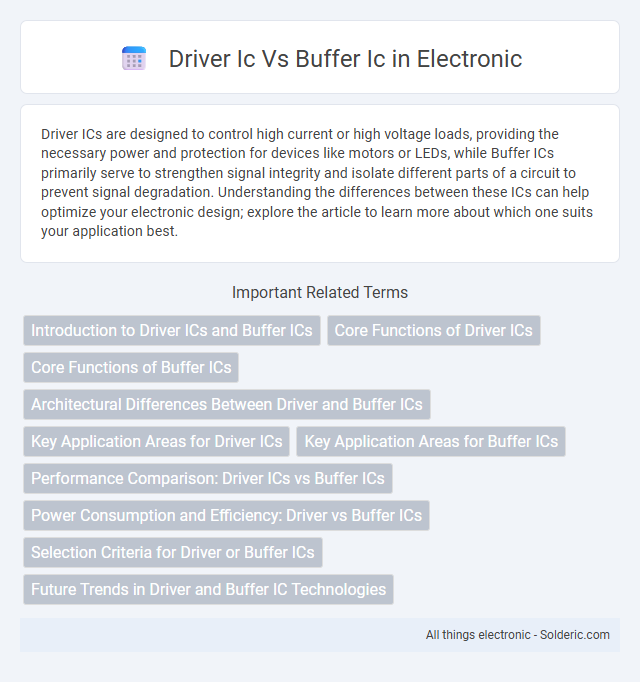Driver ICs are designed to control high current or high voltage loads, providing the necessary power and protection for devices like motors or LEDs, while Buffer ICs primarily serve to strengthen signal integrity and isolate different parts of a circuit to prevent signal degradation. Understanding the differences between these ICs can help optimize your electronic design; explore the article to learn more about which one suits your application best.
Comparison Table
| Feature | Driver IC | Buffer IC |
|---|---|---|
| Primary Function | Controls and powers high-current loads | Isolates and protects circuit stages |
| Output Capability | High current and voltage output | Moderate current; signal amplification |
| Typical Applications | LED drivers, motor drivers, display drivers | Signal buffering, line driving, logic level shifting |
| Signal Type | Power control signals | Logic or analog signals |
| Complexity | More complex due to power handling | Simpler circuitry focused on signal integrity |
| Protection | Often includes overcurrent and thermal protection | Provides signal isolation and prevents loading |
| Examples | ULN2003, L293D | 74HC125, 74LS244 |
Introduction to Driver ICs and Buffer ICs
Driver ICs primarily function to control high-current loads in applications such as LED displays and motors by amplifying input signals to drive these components efficiently. Buffer ICs are designed to isolate different stages of a circuit, preventing signal degradation and ensuring stable voltage levels for sensitive electronics. Both driver and buffer ICs play crucial roles in signal integrity and power management across various digital and analog systems.
Core Functions of Driver ICs
Driver ICs primarily serve to amplify or control high-current loads, enabling the operation of devices such as LEDs, motors, and display panels by providing the necessary voltage and current levels. They ensure signal integrity by efficiently managing power delivery without distortion, which is critical for applications requiring precise control. Your choice of a driver IC impacts device performance, especially in high-speed or high-power environments, distinguishing it from buffer ICs that mainly focus on signal buffering and isolation.
Core Functions of Buffer ICs
Buffer ICs serve as intermediaries that amplify or isolate signals to protect sensitive components and improve signal integrity in electronic circuits. Their core functions include impedance matching, signal amplification, and preventing loading effects on the preceding stage, ensuring stable data transmission. Unlike driver ICs that primarily focus on driving heavy loads, buffer ICs maintain signal fidelity while offering minimal signal distortion.
Architectural Differences Between Driver and Buffer ICs
Driver ICs feature built-in amplification stages designed to control high-current loads, enabling efficient signal transmission over long distances or to power devices such as motors and displays. Buffer ICs primarily provide signal isolation and impedance matching without significant amplification, preventing signal degradation and protecting the source from load variations. Understanding these architectural differences ensures your circuit design effectively manages power and signal integrity for optimal performance.
Key Application Areas for Driver ICs
Driver ICs are essential in display technologies, such as LCDs and OLED panels, where they control pixel activation and color rendering with high precision. They are widely used in LED displays and automotive instrument clusters to manage complex signal driving requirements and improve visual performance. Industrial automation systems also rely on driver ICs to interface sensors and actuators efficiently, ensuring accurate data transmission and operational reliability.
Key Application Areas for Buffer ICs
Buffer ICs play a crucial role in digital circuits by isolating different stages to prevent signal degradation and ensuring stable voltage levels. They are commonly used in memory address driving, data bus driving, and signal amplification applications where signal integrity and timing are critical. Your systems benefit from Buffer ICs in high-speed data transfer, synchronization tasks, and interfacing between components with differing electrical characteristics.
Performance Comparison: Driver ICs vs Buffer ICs
Driver ICs provide higher current driving capabilities and faster switching speeds compared to Buffer ICs, making them ideal for applications requiring robust signal amplification and long transmission distances. Buffer ICs excel in signal isolation and impedance matching, ensuring signal integrity with minimal distortion or delay but generally offer lower drive strength. Performance trade-offs between Driver and Buffer ICs depend on the specific load requirements and signal conditioning needs in electronic circuit designs.
Power Consumption and Efficiency: Driver vs Buffer ICs
Driver ICs typically consume more power than buffer ICs due to their capability to drive higher current loads and longer transmission lines. Buffer ICs prioritize signal integrity and low power consumption by providing signal amplification with minimal output current requirements. Choosing between driver and buffer ICs depends on the balance between power efficiency and the need for robust signal driving strength in specific applications.
Selection Criteria for Driver or Buffer ICs
Selection criteria for driver ICs versus buffer ICs depend on signal integrity, load capacity, and switching speed required by your application. Driver ICs are ideal for high current drive and long-distance signal transmission, while buffer ICs excel at isolating and stabilizing signals with low power consumption. Consider factors such as voltage levels, input/output impedance, and timing characteristics to ensure optimal performance.
Future Trends in Driver and Buffer IC Technologies
Future trends in driver and buffer IC technologies emphasize increased integration with advanced semiconductor processes such as 7nm and below, enabling higher speed and lower power consumption for data transmission. Emerging driver ICs incorporate adaptive equalization and machine learning algorithms for optimized signal integrity across diverse communication standards like PCIe 5.0 and DDR5. Buffer IC developments focus on enhanced timing accuracy and multi-channel synchronization to support the growing demands of AI acceleration and 5G infrastructure, ensuring reliable high-speed data buffering and distribution.
driver ic vs buffer ic Infographic

 solderic.com
solderic.com